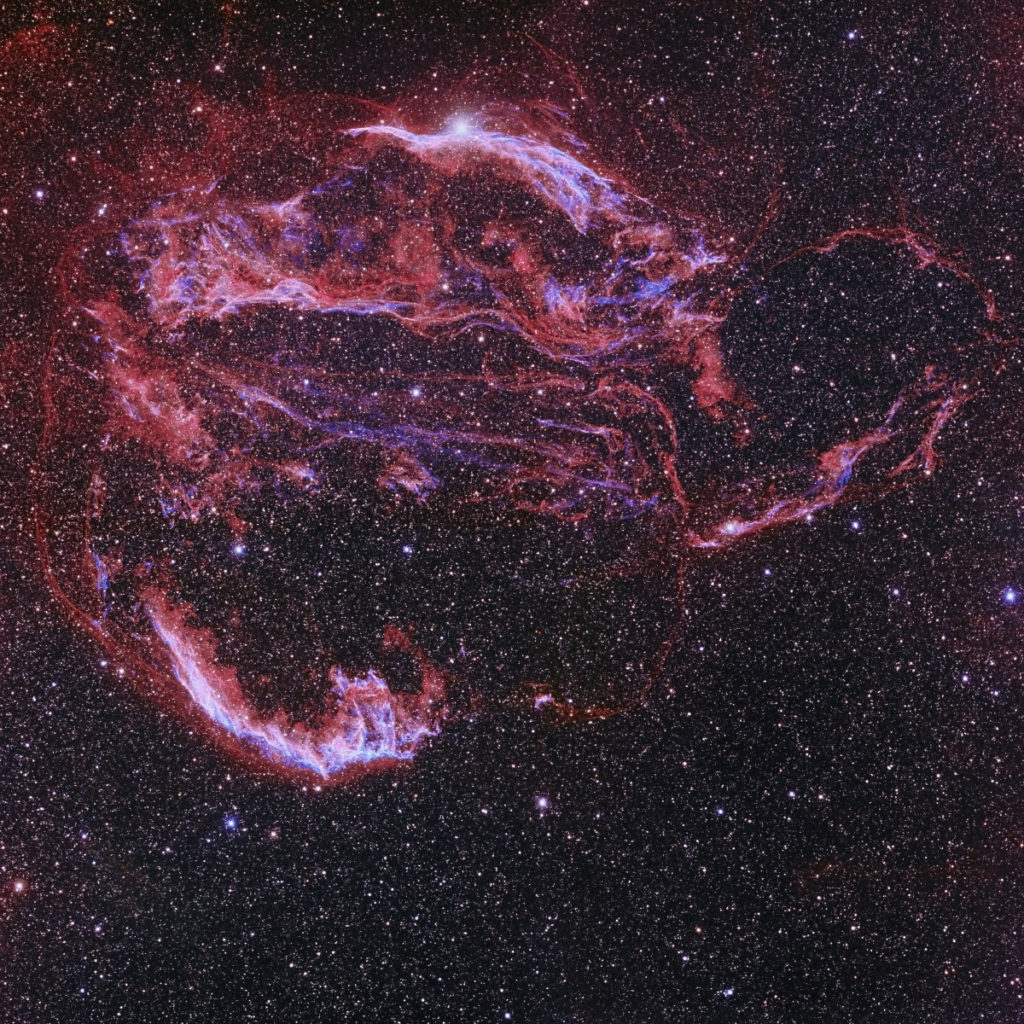Of the events that occur in the universe, few rival the spectacle of a star “going supernova.” If a star is sufficiently massive, when it can no longer sustain its nuclear furnace, the star will collapse upon itself. Its interior will reach temperatures of hundreds of millions of degrees, and it literally blows itself apart. For a few weeks, that single event produces more light than the rest of its host galaxy combined. The explosion produces an expanding shock wave that takes tens of thousands of years to dissipate. We know these shock waves as Supernova Remnants. The Cygnus Loop is one of these.

Spanning a section of sky at least five full moons across, the Cygnus Loop is the most spectacular supernova remnant in the northern sky. It’s a few thousand years old, and still expanding at a five hundred thousand miles per hour. As it expands, it collides with the undisturbed gas and dust in the area, heating those gasses until they glow. The hotter they are, the brighter they glow, and their color tells us their composition. Red is hydrogen and blue-green is oxygen.
The arc that forms the lower boundary of the nebula in the image is called “The Veil Nebula.” It’s a personal favorite of mine. As a young boy, an image of this nebula ignited in me a curiosity about the universe that still drives me. The Veil actually trails the leading edge of the shock front, the wispy red line that can be traced around the entire complex.
We find the “Witches Broom” nebula at the top of the image. Honestly, I don’t see a broom or a witch, but that’s what it’s come to be called. It bisected by a bright naked-eye star, unassumingly named 52 Cygni, so named because it was determined to be the 52nd brightest star in the constellation Cygnus. Between the Veil and the Witches Broom, we see a sinuous nebulosity that terminates in a triangular shaped region called “Pickering’s Triangle.” It was discovered by Williamina Flemming, one of E.C. Pickering’s famous “Computers,” a group of talented women who worked for him at the Harvard College Observatory in the early 1900’s.
The irregular shape of this shock front is the result of variations in the density of the gasses and dust in the region. When the shock wave encounters denser medium, it slows down, releasing some of its kinetic energy as heat and light. This lets us understand the nature of the matter throughout the area, because where the brightness of the nebulosity attests to the density of the otherwise unobserveable matter.
Supernovae are one of the primary mechanisms for spreading elements heavier than hydrogen into the environment. Manufactured in the final seconds of the doomed star’s life, elements throughout the periodic table are created in incredible amounts and blasted into the same stuff the resulting shock wave will compress to trigger star formation activity. So the end of a star’s life is the beginning of the lives of many stars. Those stars will incorporate the heavy elements created by the supernova. The forming stars also create disks of matter, orbiting the gravitational center of the system. Those disks are chock full of everything it takes to make planets. Our planet formed in exactly the same way. Every atom in our planet and its atmosphere heavier than Hydrogen was transported from an ancient supernova site to the place where our solar system formed. You and I are made from the same stuff.
The Cygnus Loop, and innumerable other examples long since faded, are where the matter that makes up everything came from. This image does not show the death of a star. It shows the beginning of everything.